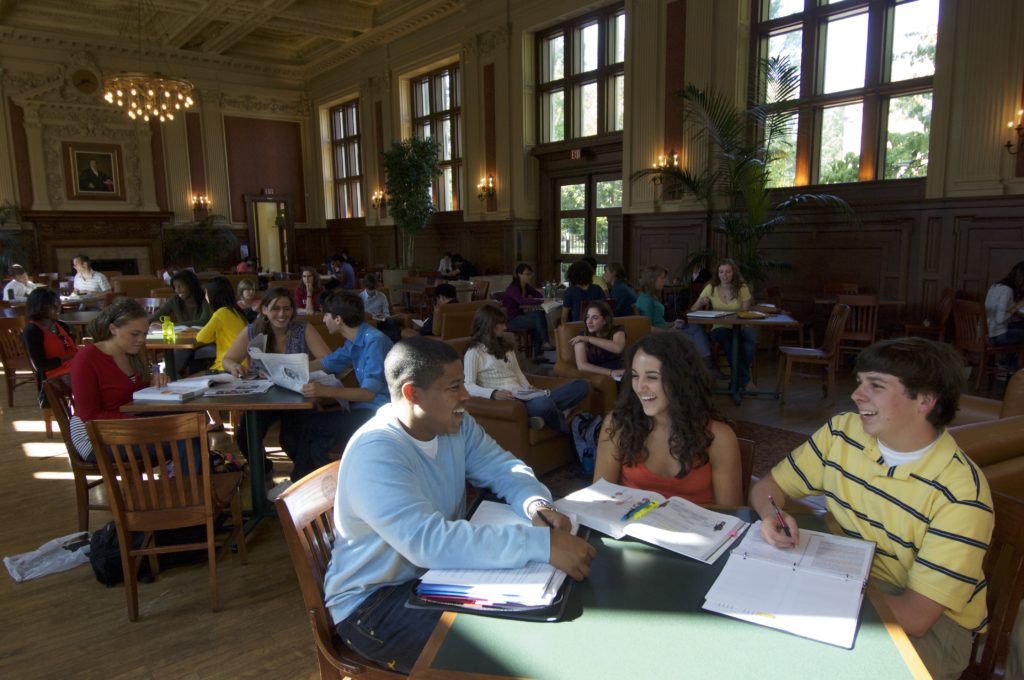Holmes Lounge provides an elegant setting for jazz performances, fashion shows and other special events at Washington University in St. Louis.
Located between Eads and Ridgley Halls on the Danforth Campus, Holmes Lounge also serves as a central gathering place for students, faculty, staff and visitors.
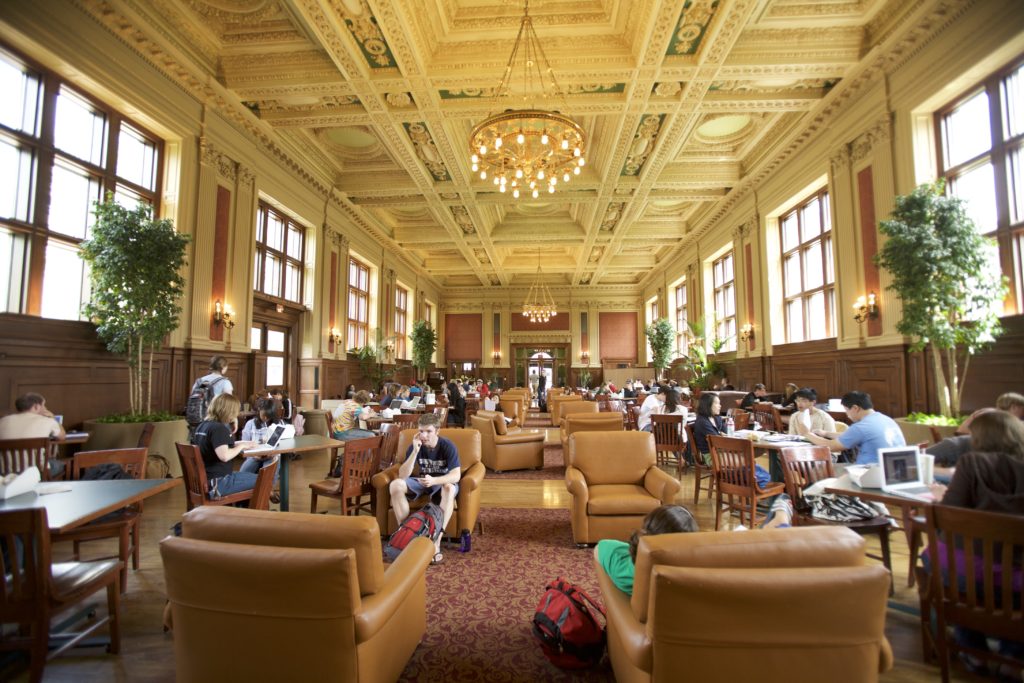
Mary Brooks Holmes
Mary Brooks Holmes was involved in many organizations including the St. Louis Country Club, Colonial Dames of America, the Colony Club of New York, and the Garden Club of America.
Her husband was J. Howard Holmes, an officer of the John A. Holmes Lumber Company. Mrs. Brooks was a philanthropist in St. Louis and gave to Barnes Hospital and Washington University. She died in 1965.
Holmes Lounge: How It Happened
One of the most beautiful facilities on the Washington University campus, Holmes Lounge has been a place for student get-togethers, home to small jazz concerts, art openings and shows, special dinner functions and student meetings since March 1964.
Holmes Lounge owes its existence to the St. Louis 1904 World’s Fair and the 1803 Louisiana Purchase. In the early 1900’s, St. Louis was gearing up for the World’s Fair and the year anniversary of the Louisiana Purchase, and the city was busy building new infrastructure and improving facilities. Graduates of Washington University were called upon to help clean up the city’s water system, and four new buildings were constructed on campus, of which the last was Ridgley Library. The Ridgley Library was particularly magnificent, built in the English Renaissance style and boasting a large reading room called Ridgley Hall. During the World’s Fair, the building was leaded to the Louisiana Purchase Exposition Company and the second floor was used to house Queen Victoria’s Diamond Jubilee gifts, while the large hall on the first floor was used for meetings and as a ballroom to entertain dignitaries.
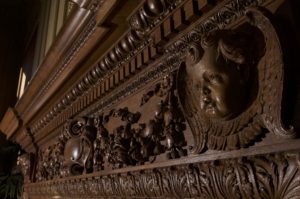 For many years, this was the primary library facility with a reference desk and general purpose reading room of the university library. Many alumni still recall studying in this room anointed with solid wood furniture and Tiffany lamps. In 1963, Olin Library was built, and the university needed to figure out what to do with the space. Chancellor Thomas Eliot appointed a small committee made up representatives of faculty, administration and students to study the possible uses for this facility and report its findings.
For many years, this was the primary library facility with a reference desk and general purpose reading room of the university library. Many alumni still recall studying in this room anointed with solid wood furniture and Tiffany lamps. In 1963, Olin Library was built, and the university needed to figure out what to do with the space. Chancellor Thomas Eliot appointed a small committee made up representatives of faculty, administration and students to study the possible uses for this facility and report its findings.
The committee consisting of Professor Leon A. Gottfried, chairman of the Department of English in Arts & Sciences; Earl R. Stuckmeyer, assistant to the vice chancellor for business and finance; Mary J. Maudsley, Arts & Sciences; and Suren G. Dutia, School of Engineering & Applied Science, met for several months and determined that the hall should be used as an interim gathering facility. At that time, there was no space for students to meet with other students or faculty, to relax between classes, or for alumni or parents to come visit when they were on campus. The idea was presented to Chancellor Eliot, who gave it his blessing and passed the project onto his assistant, Dr. Lattie F. Coor, assistant chancellor, for implementation. Because there was not much of a budget to cover administrative costs, Dr. Coor decided to hire a graduate student to implement the recommendations instead of hiring a full time administrator. Suren G. Dutia, who worked as assistant to Dr. James M. McKelvey, dean of the School of Engineering, was appointed as the supervisor of the project on a half-time basis. Under his direction, 15 students were hired on a part-time basis to transition the space to a student lounge.
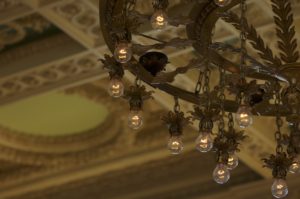 One of their first tasks was to raise the necessary funds to transform the hall and operate the lounge. In November 1963, thanks to Dr. Coor, a gift from the Mary Brooks Holmes Charitable Trust was received and dedicated to renovate, furnish and operate the lounge. Mary Brooks Holmes and her husband J. Howard Holmes, were quite philanthropic and were involved with several organizations including the St. Louis Country Club, Colonial Dames of America and Barnes Hospital. Thanks to this financial support, Holmes Lounge went under a major overhaul, including new flooring and lighting, paint, new kitchen equipment, china and even three new oriental carpets. A new door was cut in the north wall to allow an entrance from Olin Library and Dunker Hall. Robert Vickery, the campus architect, helped to consult for design and decorations. Furniture was ordered, including 40 Bentwood chairs, 40 Corbusier Bentwood chairs, 8 Herman Miller cocktail tables, 14 Herman Miller dining tables, 4 Stow and Davis leather couches, and 8 matching leather chairs.
One of their first tasks was to raise the necessary funds to transform the hall and operate the lounge. In November 1963, thanks to Dr. Coor, a gift from the Mary Brooks Holmes Charitable Trust was received and dedicated to renovate, furnish and operate the lounge. Mary Brooks Holmes and her husband J. Howard Holmes, were quite philanthropic and were involved with several organizations including the St. Louis Country Club, Colonial Dames of America and Barnes Hospital. Thanks to this financial support, Holmes Lounge went under a major overhaul, including new flooring and lighting, paint, new kitchen equipment, china and even three new oriental carpets. A new door was cut in the north wall to allow an entrance from Olin Library and Dunker Hall. Robert Vickery, the campus architect, helped to consult for design and decorations. Furniture was ordered, including 40 Bentwood chairs, 40 Corbusier Bentwood chairs, 8 Herman Miller cocktail tables, 14 Herman Miller dining tables, 4 Stow and Davis leather couches, and 8 matching leather chairs.
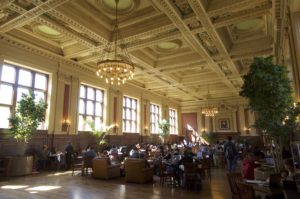
The space was transformed and Chancellor Eliot officially opened the Mary Brooks Holmes Lounge in March 6, 1964 with an open house for students, faculty and staff. Seating around 125 people in three separate communal areas and a small dining room, Holmes Lounge was open Monday through Saturday for casual conversations, faculty-student informal meetings, and relaxation.
With the proactive involvement of Lattie Coor, the space was transformed by borrowing and rotating art pieces from the Steinberg Galley and displaying them in the lounge. An original Rodin sculpture was featured in the center of the room for some time, along with de Kooning, Picasso and modern oil paintings. To help make the space sustainable, a small coffee shop was created and run by Marjorie Reed and her food service team where tea, coffee, donuts and pastries were served. Originally planned to serve around 100-150 students, the lounge was frequented by as many as 1,000 students daily. In a mere 14 months, the operation was breaking even.
While the Holmes Lounge was again renovated in 1997, much remains the same, such as the ornate ceiling, intricate wood work and beautiful wood paneling, and grand fireplace. Today, the lounge continues to be a popular gathering and relaxing place for students, faculty, staff, and visiting alumni and family members. On some evenings, students and faculty, along with members of the university community, can enjoy performances in Holmes Lounge by local and regional jazz musicians.
